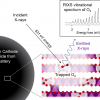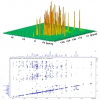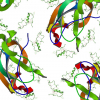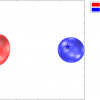
Magritek has made benchtop NMR suitable for rapidly identifying and quantitating analytes during chemical reactions in batch and continuous flow processes. This significant advancement in NMR has been achieved by Magritek thanks to the improved magnet performance of its Spinsolve ULTRA system, which enables effective and robust solvent suppression.
Now, scientists can run NMR experiments on samples dissolved in standard protonated solvents. By eliminating the need for lengthy sample workup routines, typically used to replace regular with deuterated solvents, samples can now go directly from the reactor into the NMR spectrometer for immediate and automated analysis.
Protonated solvents emit large signals, which can cover a significant fraction of the proton spectrum, overlapping with the signals of the products dissolved in the sample. Highly selective solvent suppression methods, like PRESAT or WET, have been developed to suppress the solvent signals. These methods were previously a challenge for benchtop NMR systems because they require a highly stable and homogeneous magnetic field, which is technically demanding to achieve given the small size of the magnets required for benchtop systems. The superior homogeneity of Magritek’s Spinsolve ULTRA magnets addresses this challenge and boosts the performance of the suppression methods. The result is that the residual signals of the protonated solvents after suppression are comparable to the minimal signal of any remaining protons in deuterated solvents used in high field NMR.
Federico Casanova, CEO of Magritek, commented: “The homogeneity of the magnetic field we achieve with the Spinsolve ULTRA models makes it possible to attenuate the solvent peaks by two to three orders of magnitude. In this way, the overlapping of the analyte and solvent signals is reduced to the point where the analytes can be detected baseline-separated. We have allowed scientists to conduct NMR analysis without deuterated solvent and achieve the same results as if they had used them. Scientists can now take accurate NMR measurements directly from a reactor, saving them the time, money, and expertise required to use complex high-field NMR in a dedicated facility.”
Magritek's compact benchtop NMR instruments, together with connection hardware and a dedicated software module, can now be used to determine reaction kinetics and monitor process endpoints in real-time, directly in the lab.
The effectiveness of the Spinsolve system is evidenced by the increasing number of studies in which it is employed. For instance, the Kappe group at the University of Graz recently published a paper demonstrating the use of Spinsolve for real-time process analytics in developing an autonomous self-optimizing flow reactor. Additionally, a collaboration between the Cronin group at the University of Glasgow and the German Federal Institute for Materials Research and Testing (BAM) has integrated the Spinsolve as a critical component of their "Computer," a fully automated synthesis robot. The Chemputer now employs benchtop NMR to analyse the reactions being conducted online.
Jürgen Kolz, Head of Applications Development of Magritek, stated, "These recent works by esteemed leaders such as Kappe and Cronin, coupled with numerous other instances of NMR becoming more accessible to researchers, align with our mission to make NMR available to every chemistry laboratory. With the recent advancements we've achieved in Spinsolve ULTRA magnets and technology, we are unlocking even greater possibilities for NMR. This enables scientists to address questions in real-time, advance their knowledge, and accelerate their time to obtain results."











